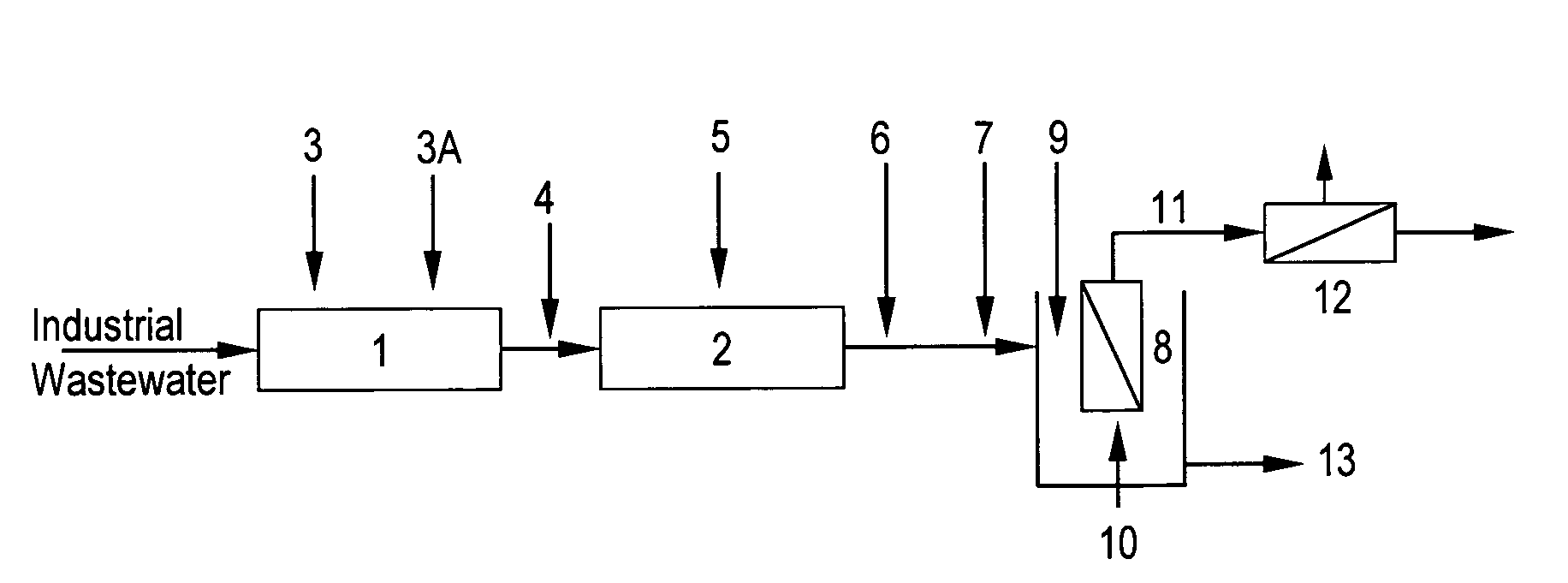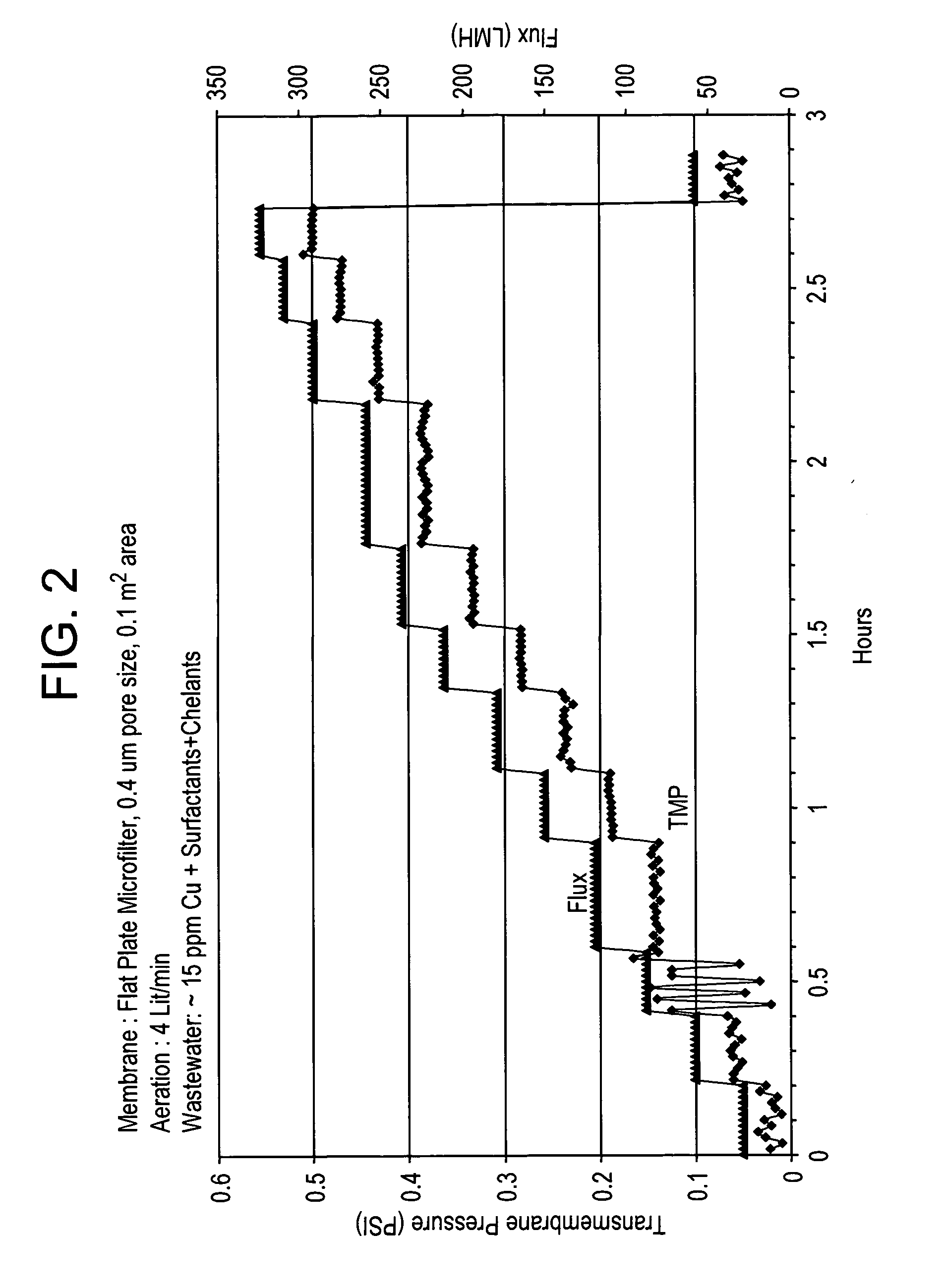Method of heavy metal removal from industrial wastewater using submerged ultrafiltration or microfiltration membranes
a technology of industrial wastewater and ultrafiltration membrane, which is applied in the direction of separation process, membrane, treatment water, etc., can solve the problems of high metal removal, high membrane flux, and high operating cost of these processes
- Summary
- Abstract
- Description
- Claims
- Application Information
AI Technical Summary
Benefits of technology
Problems solved by technology
Method used
Image
Examples
example 1
[0060]Industrial wastewater containing 15 ppm of copper, surfactants, and chelants was obtained from a circuit board manufacturing company and placed in a tank equipped with an overhead mixer. The pH was adjusted to 3.0 with sulphuric acid. Then 190 ppm ferric sulphate was added and mixed for 2 minutes. The pH was then adjusted to 8.0 with 25% sodium hydroxide and a 180 ppm of ethylene dichloride-ammonia polymer, functionalized with carbon disulfide and available from Nalco Company, 1601 West Diehl Road, Naperville, Ill., was added and mixed for 3 minutes. This treated wastewater was then placed in membrane tank. Initially, lower flux of 30 LMH was applied while monitoring the TMP. After 10 minutes, flux was increased to 59 LMH and again the TMP measured. This process was continued up to 300 LMH flux. During these measurements, permeate was recycled back into the feed tank and no concentrate was purged out, which means the metal and solids concentration in the membrane tank was cons...
example 2
[0062]Similar protocol was used as in Example 1, but with industrial wastewater containing 773 ppm Cu and also surfactants and chelants. This wastewater was also obtained from circuit board manufacturing company. The ferric sulphate and dosage of said ethylene dichloride-ammonia polymer used in this example were 3000 ppm and 2100 ppm respectively. The TMP-flux data is shown in FIG. 3. Even in presence of much higher level metal, other foulants and treatment chemistries, critical flux was not detected even after 300 LMH flux operation. The permeate turbidity was again 0.09-0.12 NTU and permeate Cu++ varied between 0.09 to 14 ppm. The reduction of Cu++ from 773 to even 14 ppm is over a 98% reduction, which is significant, while allowing the stable operation, i.e. no membrane fouling, at higher fluxes.
example 3
[0063]In this example, 24 L of simulated wastewater containing 100 ppm Cu++ and 590 ppm EDTA-Na4 (Tetrasodium salt of ethylene diamine tetra-acetic acid) was treated the same way as in Example 1. The ferric sulphate and said ethylene dichloride-ammonia polymer were 1300 ppm and 300 ppm, respectively. After polymeric chelant treatment, 5 ppm of a DMAEA.MCQ-AcAm copolymer having 50 mole % cationic charge, was also added and mixed for 2 minutes. Here, both permeate and reject / concentrate were discharged while constantly adding the treated feed in the membrane tank to maintain the level of 7 L. The final concentration factor in FIG. 4 means a ratio of initial feed volume (24 L) / final retentate volume (7 L), i.e. the solids in the feed were concentrated 3.4 times at the end of the experiment at each of the both fluxes studied.
[0064]As seen from FIG. 4, even after 3.4 times concentration, TMP remained low and almost constant with time (or volume concentration) at both 266 and 317 LMH flux...
PUM
 Login to View More
Login to View More Abstract
Description
Claims
Application Information
 Login to View More
Login to View More - R&D
- Intellectual Property
- Life Sciences
- Materials
- Tech Scout
- Unparalleled Data Quality
- Higher Quality Content
- 60% Fewer Hallucinations
Browse by: Latest US Patents, China's latest patents, Technical Efficacy Thesaurus, Application Domain, Technology Topic, Popular Technical Reports.
© 2025 PatSnap. All rights reserved.Legal|Privacy policy|Modern Slavery Act Transparency Statement|Sitemap|About US| Contact US: help@patsnap.com



